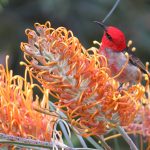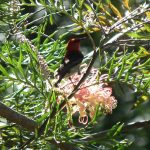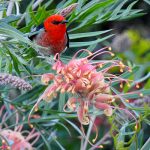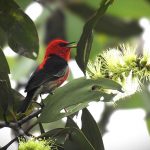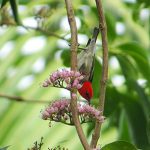SCARLET HONEYEATER
Eucalyptus forests, woodlands, heathlands, and well-tended gardens bursting with nectar-laden blooms are among the habitats this species calls home.
The male Scarlet Honeyeater is a sight to behold with his resplendent scarlet feathers adorning his head, throat, and upper breast, creating a striking contrast against his sleek black wings and tail. This radiant red plumage isn’t just for show; it plays a pivotal role in courtship and territorial defence during the breeding season.
In comparison, the females and young birds are cloaked in a subtler attire, with their plumage interweaving shades of green and yellow.
Feasting primarily on the sweet nectar of flowers, the Scarlet Honeyeater employs its finely adapted brush-tipped tongue to sip these sugary delights. Yet, their diet is not solely vegetarian; insects and spiders are also on the menu, providing essential protein to sustain them, particularly throughout the breeding months.
The breeding season, spanning from September to February, sees these birds artfully constructing their cup-shaped nests. Fashioned from strips of bark, blades of grass, and the silken threads of spider webs, these nests are often cradled within the outer branches of trees or shrubs.
While the female diligently incubates the eggs and nurtures the hatchlings, the male may partake in provisioning food.
The migratory habits of the Scarlet Honeyeater are somewhat variable. Some choose to stay put all year in their natal territories, while others are compelled to traverse to new locales as the availability of their floral food sources shifts with the seasons.
Vocal talents are abundant in the Scarlet Honeyeater, with the males serenading potential mates and proclaiming their dominion with a repertoire of rich, high-pitched melodies during the breeding season.
Despite their petite size, these birds are a whirlwind of energy, zipping through dense foliage with remarkable agility as they seek out their next meal.
As they flit from bloom to bloom, Scarlet Honeyeaters unwittingly become agents of pollination, their bodies dusted with pollen that they transport between plants, thus playing a subtle yet essential role in the propagation of various flora.


